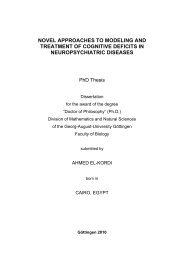Cortical and subcortical mechanisms in persistent stuttering ...
Cortical and subcortical mechanisms in persistent stuttering ...
Cortical and subcortical mechanisms in persistent stuttering ...
You also want an ePaper? Increase the reach of your titles
YUMPU automatically turns print PDFs into web optimized ePapers that Google loves.
Chapter 1 Introduction<br />
1 Introduction<br />
Stutter<strong>in</strong>g is a speech disorder that occurs without known orig<strong>in</strong> between 3 <strong>and</strong> 8 years of age<br />
<strong>and</strong> often remits before puberty. When it persists after puberty it becomes a chronic adult<br />
speech disorder throughout the lifespan (Andrews et al., 1983). The advances <strong>in</strong> neuroimag<strong>in</strong>g<br />
promoted <strong>in</strong>sights <strong>in</strong>to the highly distributed system of speech production <strong>and</strong> its alterations<br />
<strong>in</strong> adulthood stutter<strong>in</strong>g. One important motivation <strong>in</strong> stutter<strong>in</strong>g research is to separate<br />
neurobiological correlates of the core symptoms of stutter<strong>in</strong>g from neurobiological correlates<br />
associated with compensation, attempts to avoid stutter<strong>in</strong>g. Results so far <strong>in</strong>dicate a variety of<br />
complex dysfunctional systems <strong>and</strong> it appeared problematic to dist<strong>in</strong>guish between<br />
<strong>mechanisms</strong> responsible for speech dysfluencies <strong>and</strong> those connected to compensation <strong>in</strong> the<br />
adult system (Ludlow, 2000). The first study of this dissertation will tie <strong>in</strong> with this problem.<br />
Another important aspect is aga<strong>in</strong> motivated by neuroimag<strong>in</strong>g studies that stress irregularities<br />
<strong>in</strong> the activation of the primary motor cortex dur<strong>in</strong>g different functional states associated with<br />
speech production. The regulation of blood supply which is the basis of functional magnetic<br />
resonance imag<strong>in</strong>g (fMRI) is correlated with summed neuronal activity but conclusions about<br />
states of cortical excitability <strong>and</strong> thus neurophysiological <strong>mechanisms</strong> are <strong>in</strong>direct. The<br />
modulation of cortical excitability is an <strong>in</strong>herent pr<strong>in</strong>ciple <strong>in</strong> the encod<strong>in</strong>g of output signal by<br />
the primary motor cortex <strong>and</strong> the method of choice to non-<strong>in</strong>vasively study this <strong>in</strong> humans is<br />
transcranial magnetic stimulation (TMS). This method is well established <strong>in</strong> Professor Paulus’<br />
Department of Cl<strong>in</strong>ical Neurophysiology, for <strong>in</strong>stance to <strong>in</strong>vestigate neuromodulation <strong>in</strong> the<br />
primary motor cortex representation of small h<strong>and</strong> muscles. One aim of the dissertation was to<br />
establish record<strong>in</strong>gs of TMS <strong>in</strong>duced motor evoked potentials (MEPs) from facial muscles.<br />
This enabled me to conduct the first study of the <strong>in</strong>tracortical excitability of the primary<br />
tongue motor representation <strong>in</strong> adults who stutter.<br />
A sem<strong>in</strong>al work motivated the third study <strong>in</strong>cluded <strong>in</strong> this dissertation: diffusion tensor<br />
imag<strong>in</strong>g (DTI) identified reduced white matter <strong>in</strong>tegrity <strong>in</strong> fibres connect<strong>in</strong>g frontal, temporal<br />
<strong>and</strong> parietal speech related areas (Sommer et al., 2002a). Affected are possibly fibres<br />
mediat<strong>in</strong>g the mapp<strong>in</strong>g of speech sounds to articulation. The <strong>in</strong>teraction of speech production<br />
<strong>and</strong> speech perception <strong>and</strong> the <strong>in</strong>terference of stutter<strong>in</strong>g with this <strong>in</strong>teraction is the topic of the<br />
third study reported <strong>in</strong> this dissertation.<br />
Dur<strong>in</strong>g the course of my doctoral studies I furthermore contributed to a longitud<strong>in</strong>al DTI<br />
study aim<strong>in</strong>g at identify<strong>in</strong>g a biological marker of stutter<strong>in</strong>g persistency at stutter<strong>in</strong>g onset. In<br />
9



